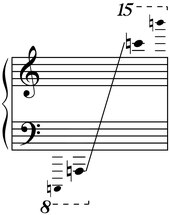
Back Klavier Afrikaans Klavier ALS ፒያኖ Amharic Piano AN Clafer ANG بيانو Arabic پيانو ARY بيانو ARZ Pianu AST Pianino Azerbaijani
This article needs additional citations for verification. (January 2024) |
Grand piano Upright piano | |
| Keyboard instrument | |
|---|---|
| Hornbostel–Sachs classification | 314.122-4-8 (Simple chordophone with keyboard sounded by hammers) |
| Inventor(s) | Bartolomeo Cristofori |
| Developed | Early 18th century |
| Playing range | |
 | |
The piano is a keyboard instrument that produces sound when its keys are depressed, through engagement of an action whose hammers strike strings. Modern pianos have a row of 88 black and white keys, tuned to a chromatic scale in equal temperament.
There are two main types of piano: the grand piano and the upright piano. The grand piano offers better sound and more precise key control, making it the preferred choice when space and budget allow. The grand piano is also considered a necessity in venues hosting skilled pianists. The upright piano is more commonly used due to its smaller size and lower cost.
When a key is depressed, the strings inside are struck by felt-coated wooden hammers. The vibrations are transmitted through a bridge to a soundboard that amplifies the sound by coupling the acoustic energy to the air. When the key is released, a damper stops the string's vibration, ending the sound. Most notes have three strings, except for the bass, which graduates from one to two. Notes can be sustained when the keys are released by the use of pedals at the base of the instrument, which lift the dampers off the strings. The sustain pedal allows pianists to connect and overlay sound, and achieve expressive and colorful sonority.
In the nineteenth century, influenced by Romantic music trends, the fortepiano adopted changes such as using the cast iron frame (which allowed much greater string tensions), and aliquot stringing which gave grand pianos a more powerful sound, a longer sustain, and a richer tone. Later in the century, as the piano became more common, it allowed families to listen to a newly published musical piece by having a family member play a simplified version.
The piano is widely employed in classical, jazz, traditional and popular music for solo and ensemble performances, accompaniment, and for composing, songwriting and rehearsals. Despite its weight and cost, the piano's versatility, extensive training of musicians, and widespread availability in venues, schools, and rehearsal spaces have made it a familiar instrument in the Western world.
© MMXXIII Rich X Search. We shall prevail. All rights reserved. Rich X Search


